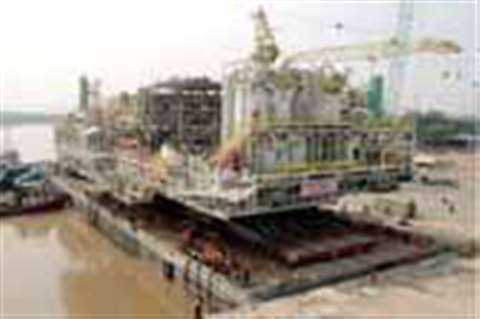Indian record
25 April 2008

The deck and module structure was fabricated and assembled by Larsen & Toubro at its Hazira yard in Gujarat State, India. The completed deck is 50.81 m long, 33.60 m wide and 8.02 m high. Including the additional modules, helipad, crane and temporary steel load-spreading frame, it reached a height of 23 m. The deck is designed to fit on a six-legged jacket structure offshore.
It was a load out challenge to the L&T team in that there were no direct support points for trailers or other means. Together with a team from Lift & Shift, Natvar Parikh Industries Ltd. (NPIL) heavy transport and installation company, designed a temporary sub-structure that allowed four side-by-side trailers to be positioned in between the legs. The structural strength of the deck was such that a group of trailers could be positioned under the front and rear sets of legs.
Due to the weight difference, however, there was a trailer set up of 4 x 16 axle lines under the front, weighing 1,442 tonnes, and 4 x 12 axle lines under the rear, weighing 1,130 tonnes. To distribute the high point loads evenly and within acceptable levels over the trailer deck, a pair of additional longitudinal load spreading beams was positioned on each trailer.
Another challenge for both teams was planning the operation due to complex tide differences at the load out quay along the Tapti River, close to the Arabian Sea. Based on extensive investigations a fixed date was set almost a year in advance.
Fast approaching
At the end of October the load out was imminent. To ascertain the exact position of the centre of gravity (CoG) the complete structure was first jacked up and weighed. The CoG was found to be just out of centre marginally in both directions. All trailers were brought to site, configured in the right axle line set up and positioned underneath the load.
Lift & Shift used hydraulic modular platform trailers from Nicolas, part of the TII Group, in France. The front group was configured using the Nicolas MDE type, including two six line and two four line self-propelled trailer modules all with a power pack. The rear group was all MHD type with only two six line self-propelled modules and power packs. According to a Lift & Shift company official, the self-propelled trailers were synchronised by a remote control for a single point manoeuvring system.
Once the land-based preparations were in full swing, preparatory work also started at the load out quay. The 110 x 35 x 7.5 m barge Abuzar was moored at the ro/ro facility and prepared for its task. A series of 28 high capacity pumps, with a capacity of 350 m3/hour, was installed on the barge deck. The pumps would be required for both the pre-ballast, load out ballast and sail out ballast.
When all preparations were completed and checked, including fitting ro/ro connecting plates between the quay and the barge, the load out went smoothly and according to plan. Despite the critical time path regarding the tide, the pumps kept the barge level during all phases of the load out.
In two years Lift & Shift, by then better known as Lift & Shift India following a rename, expects to have completed further similar heavy weight load outs of offshore structures.






